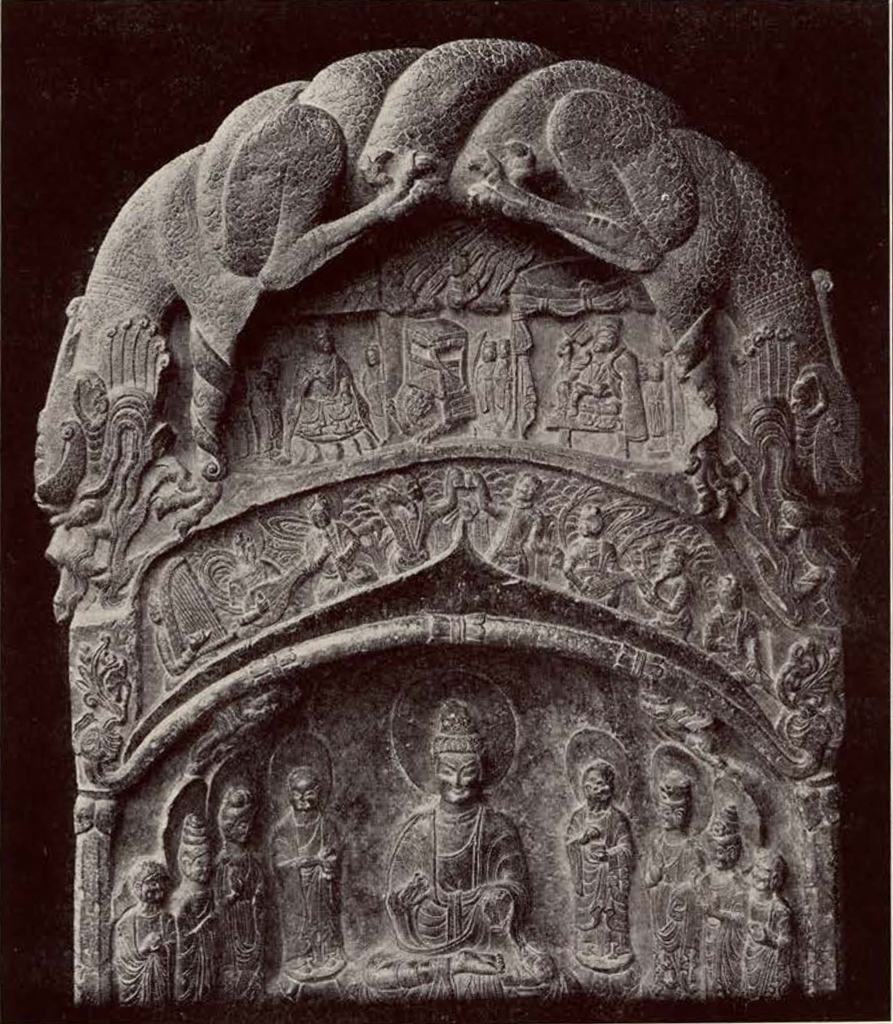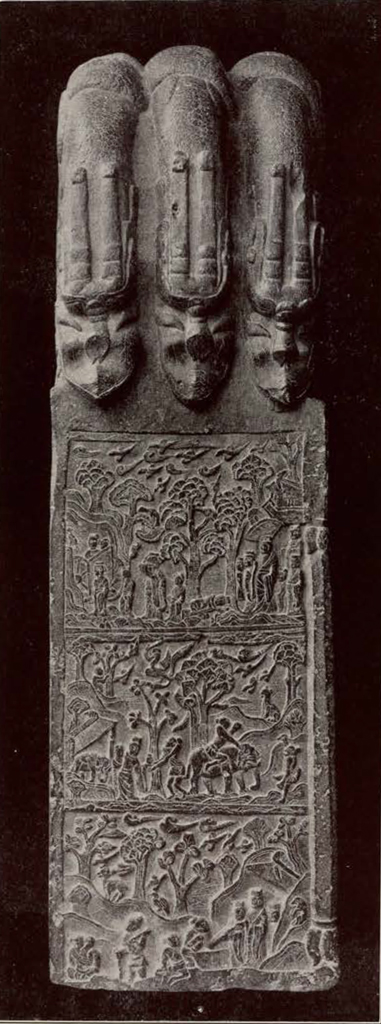The votive stela recently acquired by the Museum is one of exceptional interest and importance. Its outline and proportions are dignified and pleasing and the sculpture on the front attains high rank as a work of art. The dimensions are 39 inches by 20 inches by 11 inches. The style of the carving is that of the Wei period, a fact attested also by the date given in the inscription, 511. The grouping of the Buddha and his attendants against a plain dorneshaped background originally filled with red colour is very effective; the lines of the drapery are beautiful and like the devices below the throne, are very rich. This main theme, occupying more than one half of the front of the stone, illustrates Wei sculpture at its best. The upper part of the front, dealing with other themes, though they maintain the same excellence, are kept strictly in subordination. The left side, carved in flatter relief than the front, is by a different hand and is still more subordinated in the manner of treatment. The right side, by still another hand, is similar but a little less sure and less accomplished.

Museum Object Number: C404
There can hardly be any doubt that the back of the stone originally had an inscription giving the date and a dedication. That this should have been erased a thousand years later by the workmen of the Ming to make room for the inscription actually on the reverse is surprising.
The sculpture in front is divided into three sections, one above the other. The principal group occupies a deep recess a little more than half the height of the stone. Framing this recess is a conventional border; the lower border forming the base of the stone shows a range of mountains carved in the conventional manner in low relief. At either side is a slender column supporting the arch above. The border of this arch represents a band divided into four parts by means of lashings. Either end of the band is converted into a phoenix head turned upwards and holding a bunch of flowers.
Within this cavity under the arch is seated the Buddha on the lotus throne with a group of four personages on either side. Three of the figures on either side are those of Bodhisattvas, but the outer one on either side appears to be a priest or attendant. These figures are supported on an arrangement of lotus buds. Below the throne is the incense burner in the midst of a rich display of floral attributes representing the lotus in bloom. Within two of the lotus buds appear little human heads. This device is flanked on either side by a fu lion with flowing main, seated on a rocky mountain. At either side stands an attendant or a guardian, while on the ground below there is spread an open lotus blossom surrounded by leaves, Above the heads of the Bodhisattvas on either side of the seated Buddha is a fu lion in relief.
Above the arch, enclosing this elaborate group, are six musicians in a beautiful grove of trees and two dancers which appear to be male and not female. The musicians play a variety of instruments and two of them are represented with halos. This dancing and playing group would appear to represent the temptation of Buddha with worldly pleasures.

Museum Object Number: C404
Above this scene which is spread archwise across the stone is a small recess containing a very elaborate group of figures. At the right within a curtained tent or canopy sits the figure of a man on a throne holding a fan and with two attendants standing behind him. Outside the tent is a sedan chair borne on the back of a fu lion with two female figures standing by. On the left is a seated female figure with six attendants below a canopy which seems to represent a dragon’s jaw. Above are angels descending with flowing garments, one bearing a bowl and one a lotus bud. Above this group, the top of the stone represents the arched body of a double headed dragon which is repeated twice on the upper surface of the stone.
Each of the two narrower faces of the stone is divided into three registers, each filled with groups of human figures, quadrupeds, birds, rocks, mountains, and trees. The scenes depicted are legendary and very difficult of interpretation.
The reverse of the stone is occupied by an inscription of great interest. Mr. Paul Pelliot, the greatest living authority on Chinese epigraphy, has very kindly written me the result of his study of this inscription. Mr. Pelliot’s letter is in part as follows.
“The stele must have been originally erected on what is actually San-t’ang-ssen. i. e. 35 li. east of the district of Sin-tcheng (dependency of K’ai-fong in Honan). The reverse was originally inscribed, and was erased in order to receive the present inscription (very likely). The present inscription is divided in two parts. There is a title above: Note on the restoration of the stele on a lucky day of the 9th month of the 40th year of Kia-tsing (1561).’ The title is accompanied by the names of a certain number of distinguished persons: the subprefect of Sin-tcheng Tchou-Pang-jong and his subordinates Siao Che-cheng and Tchang Tong-tcheon, the three brothers Kao Kong, Kao Tsie and Kao To, lastly the bachelor Wang Lai-sinan. The monography of the Sin-tcheng district, a copy of which dated in 1776 was at my disposal, shows that Tchou Pang-jong was indeed the subprefect of Sin-tcheng in the last years of the reign of Kia-tsing (which ended in 1566), and Tchang Tong-tcheon is mentioned with the very title he carries here, for the year 1567, or shortly after. The three brothers are mentioned in the inscription because one of them Kao Kong (1513-1579) was at the time one of the most influential natives of Sin-tcheng; all three besides discharged in fact the offices attributed to them in the inscription. The bachelor, whose mention is not otherwise justified, may have been the author of the inscription which covers the lower part.

Museum Object Number: C404
Image Number: 141366, 1354
This lower inscription is much the longer of the two. The calligraphy was executed (as were doubtless also the title and names of the persons mentioned in the upper register) by a certain Yi Chang-tche, native from Tchong-meon (a district next to Sin-tcheng)
Yi Chang-tche recalls first that the original monument was dated on the ‘2nd year t’ien pao of the Great Tsi ‘ (551 A. D.) This fact together with the survival of the epithet “the Great” and also the beginning with a new line when mentioning a dynasty a thousand years before, makes it likely that Yi Chang-tche (or the author of the inscription, whoever he may have been), had on the date of the monument an epigraphic information that has not come down to us. Yi Chang-tche goes on to say that owing to disturbances caused by foreign invasion, the base of the monument had been destroyed. A worthy man of the village of T’ien-wang of Yang-ho territory, named Yang Chang-wan found the monument overthrown and with some others undertook to restore it and paid for the expenses. The monument was placed in a construction erected to that purpose in which Buddhistic figures were modelled, all of which took place in San-t’ang-ssen, which is built on the location of the old Chang-yu. The rest is only a list of the donators’ names in 1561; next are given the names of monks of four temples, which under the Ming and the Tsing, existed in fact, east and north of Sin-tcheng; lastly the names of the engraver, of the mason, and of the carpenter.
The following difficult points still subsist:
- Where did the author of 1561 find the date of 551?
- A line of the inscription says that “this temple formerly depended from Chan-yu; afterwards, San-t’ang-ssen was built.” But Chan-yu is according to some authorities the name of a man and not of a temple. . . .
SIN TCHENG LIEN TCHE has a fairly extensive epigraphic chapter. He mentions a monument of 558 in San-t’ang-ssen, but has no record of this one. This is not surprising since in 1776 the monument had only an inscription of 1561, not very interesting for the authors of the monography. Besides, they knew in Sin-tcheng other cases of inscriptions mentioning restorations made by the Kao family under the Ming.”



